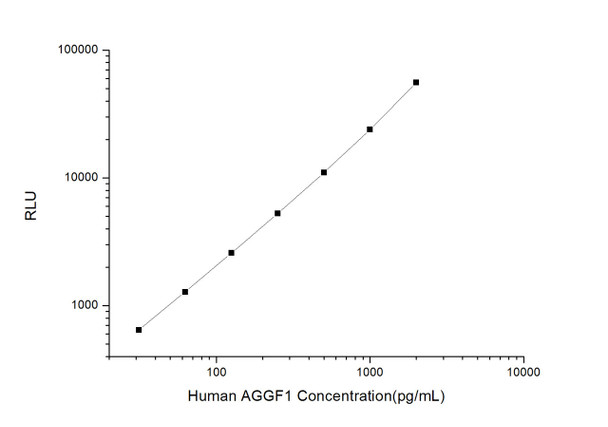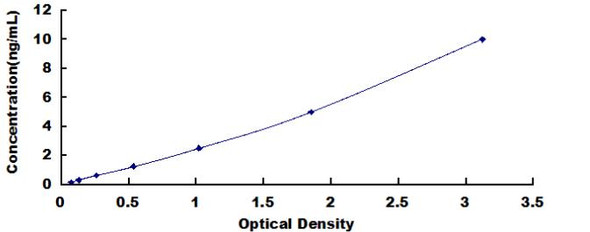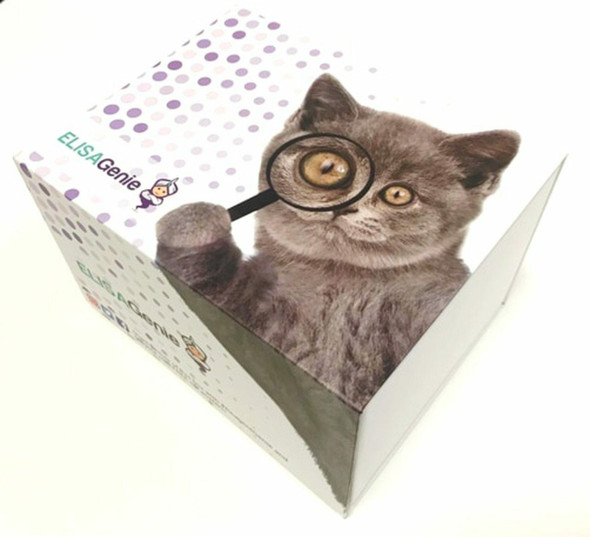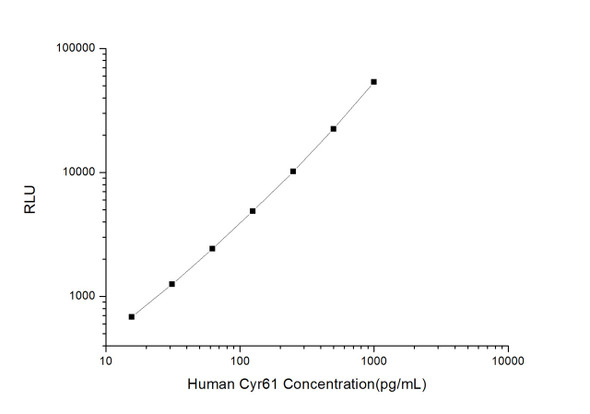Human Cardiovascular ELISA Kits
Human AGGF1 (Angiogenic Factor with G Patch and FHA Domains 1) CLIA Kit (HUES00162)
- SKU:
- HUES00162
- Product Type:
- ELISA Kit
- ELISA Type:
- CLIA Kit
- Size:
- 96 Assays
- Sensitivity:
- 18.75pg/mL
- Range:
- 31.25-2000pg/mL
- ELISA Type:
- Sandwich
- Synonyms:
- GPATC7, GPATCH7, VG5Q
- Reactivity:
- Human
- Sample Type:
- Serum, plasma and other biological fluids
- Research Area:
- Cardiovascular
Description
| Assay type: | Sandwich |
| Format: | 96T |
| Assay time: | 4.5h |
| Reactivity: | Human |
| Detection method: | Chemiluminescence |
| Detection range: | 31.25-2000 pg/mL |
| Sensitivity: | 18.75 pg/mL |
| Sample volume: | 100µL |
| Sample type: | Serum, plasma and other biological fluids |
| Repeatability: | CV < 15% |
| Specificity: | This kit recognizes Human AGGF1 in samples. No significant cross-reactivity or interference between Human AGGF1 and analogues was observed. |
This kit uses Sandwich-CLIA as the method. The micro CLIA plate provided in this kit has been pre-coated with an antibody specific to Human AGGF1. Standards or samples are added to the appropriate micro CLIA plate wells and combined with the specific antibody. Then a biotinylated detection antibody specific for Human AGGF1 and Avidin-Horseradish Peroxidase (HRP) conjugate are added to each micro plate well successively and incubated. Free components are washed away. The substrate solution is added to each well. Only those wells that contain Human AGGF1, biotinylated detection antibody and Avidin-HRP conjugate will appear fluorescence. The Relative light unit (RLU) value is measured spectrophotometrically by the Chemiluminescence immunoassay analyzer. The RLU value is positively associated with the concentration of Human AGGF1. The concentration of Human AGGF1 in the samples can be calculated by comparing the RLU of the samples to the standard curve.
| UniProt Protein Function: | AGGF1: Promotes angiogenesis and the proliferation of endothelial cells. Able to bind to endothelial cells and promote cell proliferation, suggesting that it may act in an autocrine fashion. Defects in AGGF1 are a cause of Klippel-Trenaunay syndrome (KTS). KTS is a congenital disease characterized by malformations of capillary (98% of KTS patients), venous (72%) and lymphatic (11%) vessels, and bony and soft tissue hypertrophy that leads to large cutaneous hemangiomata with hypertrophy of the related bones and soft tissues. 3 isoforms of the human protein are produced by alternative splicing. |
| UniProt Protein Details: | Protein type:RNA processing; Cell adhesion Chromosomal Location of Human Ortholog: 5q13. 3 Cellular Component: cytoplasm; extracellular region; perinuclear region of cytoplasm Molecular Function:protein binding Biological Process: cell adhesion; positive regulation of angiogenesis; positive regulation of endothelial cell proliferation; RNA processing; vasculogenesis Disease: Klippel-trenaunay-weber Syndrome |
| NCBI Summary: | This gene encodes an angiogenic factor that promotes proliferation of endothelial cells. Mutations in this gene are associated with a susceptibility to Klippel-Trenaunay syndrome. Pseudogenes of this gene are found on chromosomes 3, 4, 10 and 16. [provided by RefSeq, Sep 2010] |
| UniProt Code: | Q8N302 |
| NCBI GenInfo Identifier: | 45477317 |
| NCBI Gene ID: | 55109 |
| NCBI Accession: | Q8N302. 2 |
| UniProt Secondary Accession: | Q8N302,O00581, Q53YS3, Q9BU84, Q9NW66, |
| UniProt Related Accession: | Q8N302 |
| Molecular Weight: | 20,506 Da |
| NCBI Full Name: | Angiogenic factor with G patch and FHA domains 1 |
| NCBI Synonym Full Names: | angiogenic factor with G-patch and FHA domains 1 |
| NCBI Official Symbol: | AGGF1 |
| NCBI Official Synonym Symbols: | VG5Q; GPATC7; GPATCH7; HSU84971; HUS84971 |
| NCBI Protein Information: | angiogenic factor with G patch and FHA domains 1 |
| UniProt Protein Name: | Angiogenic factor with G patch and FHA domains 1 |
| UniProt Synonym Protein Names: | Angiogenic factor VG5Q; hVG5Q; G patch domain-containing protein 7; Vasculogenesis gene on 5q protein |
| Protein Family: | Angiogenic factor with G patch and FHA domains |
| UniProt Gene Name: | AGGF1 |
| UniProt Entry Name: | AGGF1_HUMAN |
As the RLU values of the standard curve may vary according to the conditions of the actual assay performance (e. g. operator, pipetting technique, washing technique or temperature effects), the operator should establish a standard curve for each test. Typical standard curve and data is provided below for reference only.
| Concentration (pg/mL) | RLU | Average | Corrected |
| 2000 | 51781 59661 | 55721 | 55693 |
| 1000 | 23887 24061 | 23974 | 23946 |
| 500 | 11717 10347 | 11032 | 11004 |
| 250 | 4837 5751 | 5294 | 5266 |
| 125 | 2674 2542 | 2608 | 2580 |
| 62.5 | 1355 1267 | 1311 | 1283 |
| 31.25 | 649 699 | 674 | 646 |
| 0 | 27 29 | 28 | -- |
Precision
Intra-assay Precision (Precision within an assay): 3 samples with low, mid range and high level Human AGGF1 were tested 20 times on one plate, respectively.
Inter-assay Precision (Precision between assays): 3 samples with low, mid range and high level Human AGGF1 were tested on 3 different plates, 20 replicates in each plate.
| Intra-assay Precision | Inter-assay Precision | |||||
| Sample | 1 | 2 | 3 | 1 | 2 | 3 |
| n | 20 | 20 | 20 | 20 | 20 | 20 |
| Mean (pg/mL) | 107.42 | 208.77 | 827.42 | 113.14 | 209.48 | 818.85 |
| Standard deviation | 12.57 | 16.97 | 75.96 | 13.36 | 14.79 | 73.70 |
| C V (%) | 11.70 | 8.13 | 9.18 | 11.81 | 7.06 | 9.00 |
Recovery
The recovery of Human AGGF1 spiked at three different levels in samples throughout the range of the assay was evaluated in various matrices.
| Sample Type | Range (%) | Average Recovery (%) |
| Serum (n=5) | 88-103 | 95 |
| EDTA plasma (n=5) | 95-107 | 102 |
| Cell culture media (n=5) | 97-113 | 103 |
Linearity
Samples were spiked with high concentrations of Human AGGF1 and diluted with Reference Standard & Sample Diluent to produce samples with values within the range of the assay.
| Serum (n=5) | EDTA plasma (n=5) | Cell culture media (n=5) | ||
| 1:2 | Range (%) | 97-112 | 87-101 | 96-112 |
| Average (%) | 103 | 94 | 102 | |
| 1:4 | Range (%) | 84-95 | 100-112 | 89-103 |
| Average (%) | 90 | 105 | 95 | |
| 1:8 | Range (%) | 93-108 | 89-104 | 98-110 |
| Average (%) | 101 | 95 | 104 | |
| 1:16 | Range (%) | 99-115 | 95-111 | 100-115 |
| Average (%) | 105 | 101 | 107 |
An unopened kit can be stored at 4°C for 1 month. If the kit is not used within 1 month, store the items separately according to the following conditions once the kit is received.
| Item | Specifications | Storage |
| Micro CLIA Plate(Dismountable) | 8 wells ×12 strips | -20°C, 6 months |
| Reference Standard | 2 vials | |
| Concentrated Biotinylated Detection Ab (100×) | 1 vial, 120 µL | |
| Concentrated HRP Conjugate (100×) | 1 vial, 120 µL | -20°C(shading light), 6 months |
| Reference Standard & Sample Diluent | 1 vial, 20 mL | 4°C, 6 months |
| Biotinylated Detection Ab Diluent | 1 vial, 14 mL | |
| HRP Conjugate Diluent | 1 vial, 14 mL | |
| Concentrated Wash Buffer (25×) | 1 vial, 30 mL | |
| Substrate Reagent A | 1 vial, 5 mL | 4°C (shading light) |
| Substrate Reagent B | 1 vial, 5 mL | 4°C (shading light) |
| Plate Sealer | 5 pieces | |
| Product Description | 1 copy | |
| Certificate of Analysis | 1 copy |
- Set standard, test sample and control (zero) wells on the pre-coated plate and record theirpositions. It is recommended to measure each standard and sample in duplicate. Note: addall solutions to the bottom of the plate wells while avoiding contact with the well walls. Ensuresolutions do not foam when adding to the wells.
- Aliquot 100µl of standard solutions into the standard wells.
- Add 100µl of Sample / Standard dilution buffer into the control (zero) well.
- Add 100µl of properly diluted sample (serum, plasma, tissue homogenates and otherbiological fluids. ) into test sample wells.
- Cover the plate with the sealer provided in the kit and incubate for 90 min at 37°C.
- Aspirate the liquid from each well, do not wash. Immediately add 100µL of BiotinylatedDetection Ab working solution to each well. Cover the plate with a plate seal and gently mix. Incubate for 1 hour at 37°C.
- Aspirate or decant the solution from the plate and add 350µL of wash buffer to each welland incubate for 1-2 minutes at room temperature. Aspirate the solution from each well andclap the plate on absorbent filter paper to dry. Repeat this process 3 times. Note: a microplatewasher can be used in this step and other wash steps.
- Add 100µL of HRP Conjugate working solution to each well. Cover with a plate seal andincubate for 30 min at 37°C.
- Aspirate or decant the solution from each well. Repeat the wash process for five times asconducted in step 7.
- Add 100µL of Substrate mixture solution to each well. Cover with a new plate seal andincubate for no more than 5 min at 37°C. Protect the plate from light.
- Determine the RLU value of each well immediately.






